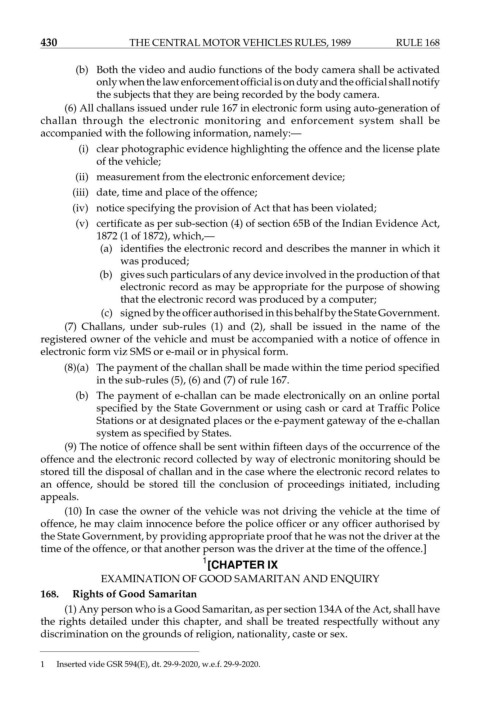Page 458 - The Central Motor Vehicles Rules, 1989
P. 458
430 THE CENTRAL MOTOR VEHICLES RULES, 1989 RULE 168
(b) Both the video and audio functions of the body camera shall be activated
only when the law enforcement official is on duty and the official shall notify
the subjects that they are being recorded by the body camera.
(6) All challans issued under rule 167 in electronic form using auto-generation of
challan through the electronic monitoring and enforcement system shall be
accompanied with the following information, namely:—
(i) clear photographic evidence highlighting the offence and the license plate
of the vehicle;
(ii) measurement from the electronic enforcement device;
(iii) date, time and place of the offence;
(iv) notice specifying the provision of Act that has been violated;
(v) certificate as per sub-section (4) of section 65B of the Indian Evidence Act,
1872 (1 of 1872), which,—
(a) identifies the electronic record and describes the manner in which it
was produced;
(b) gives such particulars of any device involved in the production of that
electronic record as may be appropriate for the purpose of showing
that the electronic record was produced by a computer;
(c) signed by the officer authorised in this behalf by the State Government.
(7) Challans, under sub-rules (1) and (2), shall be issued in the name of the
registered owner of the vehicle and must be accompanied with a notice of offence in
electronic form viz SMS or e-mail or in physical form.
(8)(a) The payment of the challan shall be made within the time period specified
in the sub-rules (5), (6) and (7) of rule 167.
(b) The payment of e-challan can be made electronically on an online portal
specified by the State Government or using cash or card at Traffic Police
Stations or at designated places or the e-payment gateway of the e-challan
system as specified by States.
(9) The notice of offence shall be sent within fifteen days of the occurrence of the
offence and the electronic record collected by way of electronic monitoring should be
stored till the disposal of challan and in the case where the electronic record relates to
an offence, should be stored till the conclusion of proceedings initiated, including
appeals.
(10) In case the owner of the vehicle was not driving the vehicle at the time of
offence, he may claim innocence before the police officer or any officer authorised by
the State Government, by providing appropriate proof that he was not the driver at the
time of the offence, or that another person was the driver at the time of the offence.]
1
[CHAPTER IX
EXAMINATION OF GOOD SAMARITAN AND ENQUIRY
168. Rights of Good Samaritan
(1) Any person who is a Good Samaritan, as per section 134A of the Act, shall have
168
the rights detailed under this chapter, and shall be treated respectfully without any
discrimination on the grounds of religion, nationality, caste or sex.
1 Inserted vide GSR 594(E), dt. 29-9-2020, w.e.f. 29-9-2020.

